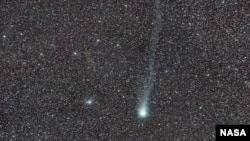A key ingredient for life on Earth may have come thanks to a comet, according to a new study.
French researchers say it’s possible that a simple sugar known as ribose arrived on Earth via a comet. Ribose is a key ingredient in RNA, which is necessary for life.
To see if their theory could in fact have happened, the researchers recreated the solar system’s early conditions in a lab by making ices out of water, methanol and ammonia, all of which are believed to have been common during the formation of the solar system.
In fact, they were found to be present on Comet 67P/Churyumov-Gerasimenko when the Philae Lander landed there in late 2014.
Then, the ices were exposed to UV radiation similar to what the sun might have emitted. The ices were then left at room temperature, and when they evaporated, they left “substantial amounts” of ribose and other organic molecules behind.
"At a certain point in prebiotic evolution, the availability of ribose would have been, therefore, necessary for life to have started," said Cornelia Meinert from the University of Nice Sophia Antipolis in France, in an interview with Space.
"Ice simulation is a very general process that can occur in molecular clouds as well as in protoplanetary disks,” Meinert told the Los Angeles Times. “It shows that the molecular building blocks of the potentially first genetic material are abundant in interstellar environments."
The organic molecules the researchers created could also be dissolved in water, according to the BBC. Without that, life would not have likely formed.
Ingredient for Life Recreated From Comet Ice
- By VOA News









